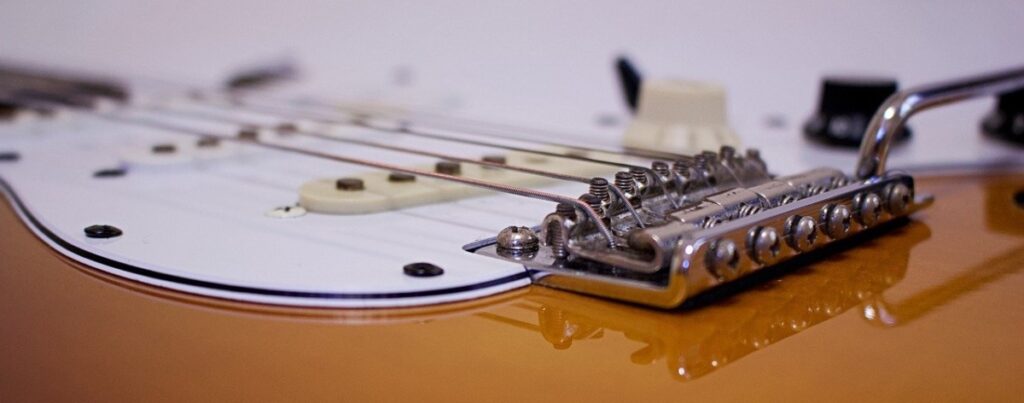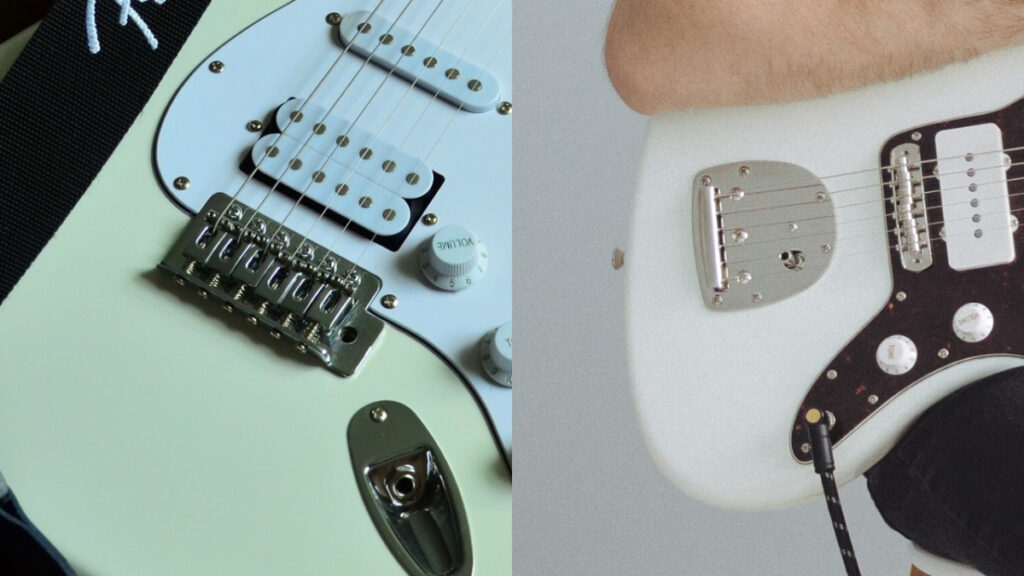The Stratocaster and Jazzmaster are two iconic guitars made by Fender and Squier, but which is the best? In this article, I’ll compare the features of each guitar type, the sound, the look and feel, and also take a look at the full Fender and Squier ranges so you can see what is available to you based on your budget.
The Quick Answer
The Stratocaster sounds brighter due to the single coil pickups compared to the Jazzmaster which sounds fuller and warmer due to its wider pickups. The Jazzmaster is usually slightly more expensive than the Stratocaster. Jazzmasters have offset body shapes unlike Stratocasters.
Comparing Features
First let’s start with the specifications. Here’s a table comparing the key features of the American Standard/ Original versions of the Fender Stratocaster and Fender Jazzmaster.
| Feature | Stratocaster | Jazzmaster |
| Body Shape | Double Cutaway | Double Cutaway |
| Body Wood | Alder | Alder |
| Pickups | Three Single-Coils | Two Wide Single Coils |
| Neck Shape | C-Shape | C-Shape |
| Neck Wood | Maple | Maple |
| Neck Construction | Bolt-On | Bolt-On |
| Frets | 22 | 21 |
| Fretboard Wood | Rosewood or Maple | Rosewood |
| Scale Length | 25.5” | 25.5” |
| Bridge | Synchronised Tremolo | Floating Tremolo |
| Weight | 8 pounds (3.6 kg) | 8.5 pounds (3.9 kg) |
Keep in mind that these are just two versions of the guitars. There are many different Fender and Squier versions of the Jazzmaster and Stratocaster available, and the specifications will vary depending on the model (more on that later).

How Does the Sound Differ?
Despite looking and feeling reasonably similar, the Stratocaster and Jazzmaster sound very different from one another.
Stratocasters sound brighter than Jazzmasters because they have three single coil pickups. Jazzmasters sound more warm and mellow by comparison, as they have wider pickups instead, and some even have humbuckers. This makes Strats better for clean styles of music, and Jazzmasters suited to higher-gain.
The main issue with using a Stratocaster with high-gain amp settings is that you get a fair bit of feedback or “humming”, due to the single coil pickups. The pickups in a Jazzmaster have a higher output and suffer less from feedback, making it a more suitable guitar for metal and heavy rock.
Of course, it’s hard to demonstrate the differences in the tone without actually hearing it. So here is a video to demonstrate the sounds of both guitars.
Key Sound Differences:
- The Stratocaster has a brighter but thinner sound.
- The Jazzmaster has a fuller and warmer sound.
- Jazzmasters produce less feedback and “hum” when using distorted amp settings.
Look and Feel
Jazzmasters and Stratocasters are both double-cutaway electric guitars, however the Strat has a more regular shape compared to the Jazzmaster which has a more offset design that is designed to be more comfortable to play.
Want to learn more about offset guitars? Check out my article discussing the pros and cons of offset body electric guitars.
Both guitars have similar neck profiles (mainly C-shape) and fairly similar weights making them both quite close together in terms of how easy they are to play and sit and stand with. The scale length is also the same.
Similarities:
- Double-cutaway body
- Thin, lightweight design
- Similar C-shape neck on most models
- Same 25.5″ scale length
- Both usually have a pickguard
Differences:
- Offset design of the Jazzmaster compared to the regular shape of the Stratocaster
- The Jazzmaster has 21 frets and the Strat has 22
- Larger pickups on the Jazzmaster
- 3 pickups on the Strat compared to the 2 on the Jazzmaster
- More colour options available on the Strat

Models Available
Now let’s take a deeper look into the Jazzmaster and Stratocaster ranges. Both guitars are made by Squier and Fender. Fender makes the more premium versions whilst Squier produce more affordable and entry-level options.
Guitar Center are always the first place I look at when I’m interested in a new electric guitar because have a huge range of models for sale and always have some excellent deals on. Here’s a link to take you directly to Guitar Center’s electric guitar range so you can see all the offers available at the moment.
Remember to scroll sideways if you’re on mobile to see the full table!
Entry-Level (under $300)
| Guitar | Origin | Body Wood | Bridge | Price |
| Squier Bullet Stratocaster | Indonesia | Basswood | Fixed | $180 |
| Squier Affinity Stratocaster | China | Alder | 6-saddle tremolo | $230 |
| Squier Affinity Jazzmaster HH | China | Alder | Fixed | $230 |
| Squier Affinity Jazzmaster | China | Poplar | 2-point tremolo | $280 |
Mid Range ($400-$1000)
| Guitar | Origin | Body Wood | Bridge | Price |
| Squier Contemporary Stratocaster | China | Poplar | Floyd Rose | $400 |
| Squier Classic Vibe Stratocaster | Indonesia | Poplar/ Pine | 6-saddle tremolo | $430 |
| Squier Classic Vibe 60’s Jazzmaster | Indonesia | Poplar | 6-saddle tremolo | $430 |
| Squier Contemporary Jazzmaster | Indonesia | Poplar | Fixed | $450 |
| Fender Player Stratocaster | Mexico | Alder | 2-point tremolo | $750 |
| Fender Player Jazzmaster | Mexico | Alder | 6-saddle tremolo | $780 |
| Fender Deluxe Stratocaster | Mexico | Alder | 2-point tremolo | $950 |
| Fender Vintera Stratocaster | Mexico | Alder | 6-saddle tremolo | $950 |
High-End (over $1000)
| Guitar | Origin | Body Wood | Bridge | Price |
| Fender Vintera Jazzmaster | Mexico | Alder | Tremolo | $1050 |
| Fender Noventa Jazzmaster | Mexico | Alder | Tremolo | $1150 |
| Fender Boxer Strat | Japan | Basswood | Floyd Rose | $1200 |
| Fender American Performer Strat | America | Alder | 2-point tremolo | $1200 |
| Fender American Professional Strat | America | Alder | 2-point tremolo | $1500 |
| Fender American Professional Jazzmaster | America | Alder | Tremolo | $1600 |
| Fender American Showcase Strat | America | Alder | 2-point tremolo | $1700 |
| Fender American Ultra Strat | America | Alder | Tremolo | $1900 |
| Fender American Ultra Jazzmaster | America | Alder/ Ash | Tremolo | $2000 |
| Fender American Original Strat | America | Alder | Tremolo | $2000 |
| Fender American Original Jazzmaster | America | Alder | Tremolo | $2030 |
Check out my complete comparison between the Stratocaster and Telecaster
Design Differences
I also wanted to compare the designs of each guitar and how this affects the tone, look and feel of each instrument. Keep in mind though that there are multiple versions of both guitars (as discussed above), so I’ll be talking about the traditional versions of the Jazzmaster and Strat.
Body
Both the Jazzmaster and Stratocaster have double cutaway bodies, making upper fret access very easy. The Jazzmaster has a slightly offset design compared to the Strat, arguably making upper fret access slightly easier. Both guitars usually have alder bodies and their comfortable design makes them easy to sit and stand with.
Neck
The Jazzmaster and Stratocaster both have similar necks on most models. They are usually C-shape (however will vary depending on the version/ era), maple and have a bolt-on construction. The fret board is usually made of either maple or rosewood, the only difference being that the Stratocaster has 22 frets and the Jazzmaster has 21.
Pickups
The pickups used on each guitar probably provides the biggest contrast between the two instruments. Stratocasters are well known for their 3-single coil pickup design, whilst Jazzmasters usually have two wide single coil pickups instead. Some Jazzmasters have two humbucker pickups instead.
- Single coil pickups have one magnet, and are brighter and suffer the most with humming and feedback when using high-gain amp settings.
- Wide single coil pickups also have one magnet, but suffer less from humming and feedback due to their wider and shorter bobbin giving them a higher output. This makes them better for distorted amp settings, and also means they sound a bit more warm and mellow compared to single coils.
- Humbucker pickups suffer the least from feedback, due to their two magnet design, and have the warmest, fullest tone with the highest output.
Some Stratocasters do have humbucker and P90 pickups, however this is rarer to see. The most common Strat variant has a humbucker pickup in the bridge, and single coil pickups in the middle and neck positions.
Check out my article comparing pickup types to learn more.
Controls
Since the Stratocaster has a 3-pickup configuration, and the Jazzmaster has a two-pickup configuration, the number of controls also varies.
- Stratocasters have a 5-way pickup selector, two tone controls, and one volume control.
- Jazzmasters have a 3-way pickup selector, lead/ rhythm switch, 2 tone controls and 2 volume controls.
On a Jazzmaster, the lead/ rhythm switch allows you to set the guitar up differently. The lead circuit allows you to use the 3-way pickup selector to activate different pickups, and use the master tone and volume controls. The rhythm switch bypasses the 3-way pickup selector, and activates only the neck pickup, and the rhythm tone and volume controls.
I’ve written a complete guide to using a Stratocaster’s controls if you want to learn about the Strat.
Bridge
Both the Stratocaster and Jazzmaster have floating bridges, meaning they have a tremolo arm. This can be pushed/ pulled on to change the pitch of the strings when playing. Although they both have floating bridges, the appearance is slightly different, with the Jazzmaster’s tremolo sitting further back on the guitar’s body.

Which is Best for You?
The best way to figure out if you should get a Stratocaster or Jazzmaster is to give them a try in the store and see what feels, sounds and looks best to you. However, to give you something more definitive, here are some things to keep in mind:
- Stratocasters sound brighter and suit clean tones the best.
- Jazzmasters suit higher gain amp settings more.
- The Stratocaster is available in more colour options and pickup configurations and has more models available to suit different budgets.
Best for Beginners?
A Stratocaster is usually recommended over a Jazzmaster for beginners because it starts at a lower price. However, both guitars are great for beginners and are comfortable to use. For beginners looking to play heavy rock and metal, a Jazzmaster may be more suitable as they suffer less from feedback.
I’ve written a complete buyer’s guide for electric guitars which takes you through all the things you need to consider and a step-by-step method to narrowing down your selection and choosing the best option. Here is a link to the article.
Here are some more articles you might find interesting:
